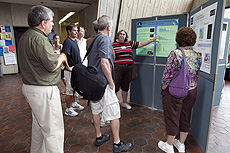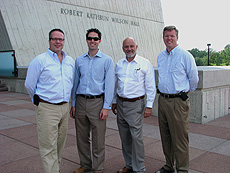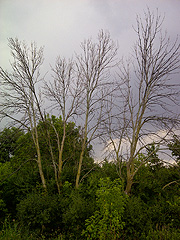|
Have a safe day!
Monday, July 23
PARTICLE ASTROPHYSICS SEMINARS WILL RESUME IN THE FALL
3:30 p.m.
DIRECTOR'S COFFEE BREAK - 2nd Flr X-Over
THERE WILL BE NO ALL EXPERIMENTERS' MEETING THIS WEEK
Tuesday, July 24
Noon
Undergraduate Lecture Series - One West
Speaker: Amitoj Singh, Fermilab
Title: High-Performance Computing at Fermilab
3:30 p.m.
DIRECTOR'S COFFEE BREAK - 2nd Flr X-Over
4 p.m.
Accelerator Physics and Technology Seminar - One West
Speaker: Aleksandr Romanov, Budker Institute of Nuclear Physics
Title: Lattice and Closed Orbit Correction at VEPP-2000 and its Possible Applications to IOTA
Click here for NALCAL,
a weekly calendar with links to additional information.
Upcoming conferences |
| Monday, July 23
- Breakfast: Croissant sandwich
- Spicy beef & rice soup
- Corned beef reuben
- Smart cuisine: Roast pork loin
- Smart cuisine: Lasagna
- Chicken oriental wrap pineapple
- Assorted sliced pizza
- Smart cuisine: Pacific rim rice bowl
Wilson Hall Cafe Menu
|
|
Wednesday, July 25
Lunch
- Ham & gruyere crepes
- Mixed greens w/ herb vinaigrette
- Fruit pie
Friday, July 27
Dinner
- Cranberry & walnut salad
- Pan-roasted monkfish w/ red-wine sauce
- Wild mushroom stuffed potatoes
- Sautéed spinach
- Pear tart
Chez Leon Menu
Call x3524 to make your reservation.
|
|
High-school physics teachers become scientists for a week at QuarkNet Boot Camp
 |
A 2011 QuarkNet Boot Camp participant presents the results of her week-long analysis at the culminating poster session. Photo: Cindy Arnold |
This week in a bit of role reversal, Fermilab scientists teach high-energy physics to high school physics teachers, while the teachers analyze data as particle physicists would do. The week-long exercise is part of the laboratory's annual QuarkNet Boot Camp.
"In one week, we put teachers through activities to get them as close to being scientists as they can," said QuarkNet Project Coordinator and Fermilab user Tom Jordan.
QuarkNet is a professional development program sponsored by DOE, NSF and participating institutions that allows physics teachers from around the United States to network with particle physicists at universities and laboratories. This year about 30 teachers from as far away as Hawaii are attending Fermilab's Boot Camp.
For the first two days, scientists will give Boot Camp participants a crash course in understanding what properties collider detectors measure. After that, participants will split into smaller groups and spend the following couple of days analyzing several data sets containing multiple observations of similar particles. The CMS collaboration has released these data for public use.
Though the learning curve is steep, the physics principles used to reconstruct an event are no different from those the teachers already know, including the conservation of energy and the conservation of momentum. QuarkNet week provides a new way to apply familiar rules.
"We give them data and have them figure it out, watch them get frustrated – but not too frustrated," Jordan said. "We don't tell them, 'It's a Z boson.' They analyze it and, by the end, they're telling us what a Z boson is."
The capstone event is the poster session, the culmination of a week of the participants' analyzing, interrogating each other and defending their arguments.
"At the start of the week the teachers are polite, deferential," Jordan said. "By Wednesday or Thursday, they're more confident, asking good questions."
The poster session will take place on Friday, July 27, at 4 p.m. in the Wilson Hall atrium, directly after the director's coffee break. All are invited to attend.
—Leah Hesla
|
U.S. Senate staffers visit Fermilab
 |
Staffers from the U.S. Senate Appropriations Subcommittee on Water and Energy Development toured Fermilab on Thursday, July 19. From left: Doug Clapp, Leland Cogliani, Pier Oddone and Chris Hanson, DOE. Photo: Joseph Piergrossi |
|
Accelerating collaboration
From Public Service Review: European Science and Technology, July 12, 2012
Editor's note: Fermilab Assistant Director Roy Rubinstein wrote this article.
Particle physics is a basic research field with no immediate commercial or military applications, and its output consists of reports in the open scientific literature. Because of this, countries have collaborated openly in its study for much of the past half-century. From its inception, Fermilab's scientific programme has been international; indeed, its first experiment was a US-USSR collaboration, which took place during the Cold War, when such collaborative activities were highly unusual. Experiments approved in the early 1970s, around the time when the Fermilab research programme began, included groups from the United States, Canada, France, Germany, India, Italy, Japan, Poland, Singapore, Spain, Switzerland, the UK and the USSR.
Today, about 2,300 scientists from research institutions in 33 countries collaborate with Fermilab in the quest to discover the fundamental laws of nature and understand how the universe works. They use the laboratory's particle accelerators and research facilities to conduct experiments addressing a wide range of questions and to develop new accelerator and particle detector technologies.
Read more
|
|
Dead tree ecology
 |
Dead trees, or snags, may not look like they belong in a healthy forest, but they are thriving habitats for all sorts of wildlife. Photo: Ryan Campbell |
If there is one fundamental principle underlying all of ecology, it may be that no niche goes unused. Essentially everywhere we look in nature, we find plants and animals exploiting the available resources and energy to make a living. One common feature of all forest environments is some number of standing dead trees, often called snags. While they may not be part of our concept of a healthy forest, they are a bonanza for wildlife and provide hundreds of organisms with comfortable habitat.
A tree can die in any of a number of ways, including pest infestation, disease, lightning strikes or windstorms. When they do, almost instantly, swarms of plants, fungi and invertebrates begin to colonize the new habitat. Fungi, mosses, insects, spiders, millipedes, centipedes and worms begin to invade the dead tissue, processing it for their own use, facilitating the decomposition and recycling of the tree. As this initial process proceeds, dozens of species of birds and mammals find the first wave of exploiters to be attractive food sources. The most familiar examples are woodpeckers and other birds foraging on snags to find the underlying insects that often burrow just under the bark. But raccoons, squirrels and bears, among others, also use the richness of the "dead tree ecosystem" to find food. As the tree tissue begins to break down, it becomes much easier for birds, mammals and insects to excavate it to make cozy dens and nests.
Recently in the midwest the emerald ash borer, a beetle that devastates ash trees, caused the near-extermination of the ash tree population and an increase in the number of snags in forests. This is not a new phenomenon. We have lived for decades with periodic outbreaks of tree pests. While their effects can be undesirable, the potential for creating more usable wildlife habitats is obvious. But this is true only if we manage forests in an ecologically conscientious way, preserving as many of the dead standing trees as possible.
At Fermilab, we have begun removing doomed ash trees, especially in the Village, but only those that would pose a safety risk if left standing. In fact, we have a general policy regarding snags that requires us to leave them as wildlife trees unless they present a hazard. This practice encourages species that might not be interested in a forest with only living, healthy trees.
—Rod Walton
|
Learning to build a cosmic ray detector
From phys.org, July 19, 2012
A three-day workshop in which high school physics teachers worked on building and using cosmic ray detectors concludes today at the University of California, Riverside. The workshop is sponsored by Quarknet, a project headquartered in Fermilab that provides professional development and on-going support for physics teachers.
Nine local high school physics teachers from Riverside and San Bernardino counties participated in the workshop, which took place in the Physics Building. The teachers will take the cosmic ray detectors they built to their classrooms for use by their students in research projects. The detectors measure the rate, energy and direction of cosmic rays.
Read more
|
|